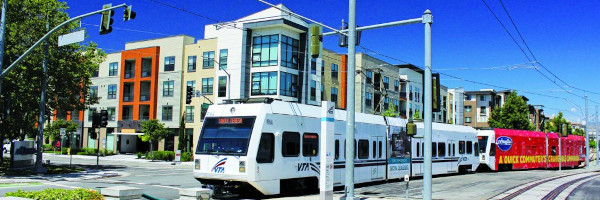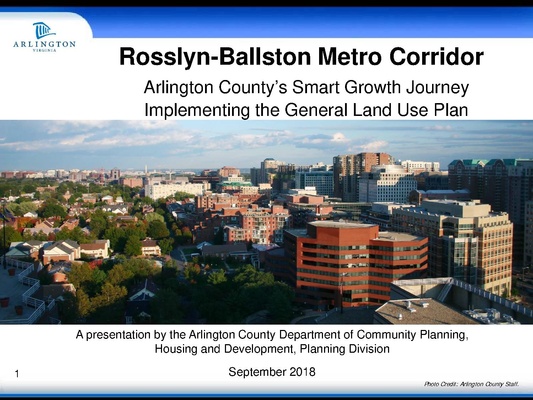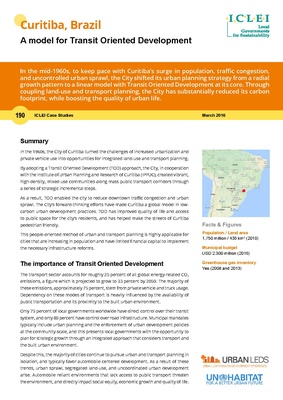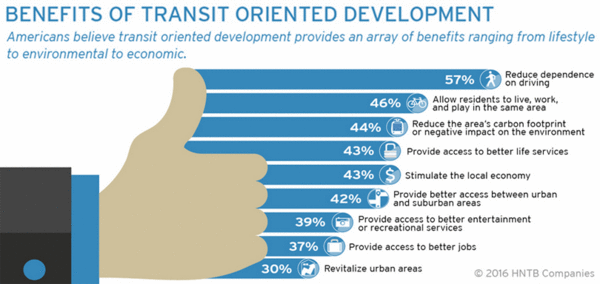Transit-Oriented Development: Difference between revisions
No edit summary |
No edit summary |
||
| (8 intermediate revisions by the same user not shown) | |||
| Line 8: | Line 8: | ||
|chapter=5005 | |chapter=5005 | ||
}} | }} | ||
__NOTOC__One of the most important benefits of Transit Oriented Development[[CiteRef::TOD 2012]] is its potential to reduce reliance on cars and improve access to public transportation. By locating new development near transit hubs, TOD can increase transit ridership, which in turn can reduce greenhouse gas emissions, improve air quality, and decrease traffic congestion. Additionally, TOD can help to create more equitable access to transit, providing greater mobility and economic opportunities to low-income communities and other underserved populations. | |||
Another important goal of TOD is to create more livable, walkable, and vibrant neighborhoods. By mixing residential, commercial, and other land uses, TOD can create vibrant, 24/7 communities where residents can live, work, and play in close proximity. This can create a more sense of community and place, and make it easier for residents to access a range of amenities and services within walking distance of their homes. | Another important goal of TOD is to create more livable, walkable, and vibrant neighborhoods. By mixing residential, commercial, and other land uses, TOD can create vibrant, 24/7 communities where residents can live, work, and play in close proximity. This can create a more sense of community and place, and make it easier for residents to access a range of amenities and services within walking distance of their homes. | ||
| Line 19: | Line 19: | ||
'''Economic benefits''': TOD can create significant economic benefits for communities. By increasing access to public transit and creating more walkable and bikeable neighborhoods, TOD can help to reduce transportation costs for residents. This can increase disposable income and boost local economic activity, as residents have more money to spend on other goods and services. Additionally, TOD can create new jobs and increase property values, which can generate tax revenue for local governments. | '''Economic benefits''': TOD can create significant economic benefits for communities. By increasing access to public transit and creating more walkable and bikeable neighborhoods, TOD can help to reduce transportation costs for residents. This can increase disposable income and boost local economic activity, as residents have more money to spend on other goods and services. Additionally, TOD can create new jobs and increase property values, which can generate tax revenue for local governments. | ||
[[File:Benefits of TOD.gif| | [[File:Benefits of TOD.gif|600px]] | ||
'''Environmental benefits''': TOD can also create important environmental benefits. By reducing car dependence and increasing transit ridership, TOD can help to reduce greenhouse gas emissions, improve air quality, and decrease traffic congestion. Additionally, TOD can help to protect natural resources by reducing urban sprawl and preserving open space. | '''Environmental benefits''': TOD can also create important environmental benefits. By reducing car dependence and increasing transit ridership, TOD can help to reduce greenhouse gas emissions, improve air quality, and decrease traffic congestion. Additionally, TOD can help to protect natural resources by reducing urban sprawl and preserving open space. | ||
| Line 26: | Line 26: | ||
Overall, Transit Oriented Development offers a range of benefits that can help to create more sustainable, livable, and equitable communities. By creating more compact, mixed-use, and pedestrian-friendly neighborhoods centered around public transit, TOD can help to reduce car dependence, improve environmental outcomes, and create more vibrant and connected communities. | Overall, Transit Oriented Development offers a range of benefits that can help to create more sustainable, livable, and equitable communities. By creating more compact, mixed-use, and pedestrian-friendly neighborhoods centered around public transit, TOD can help to reduce car dependence, improve environmental outcomes, and create more vibrant and connected communities. | ||
==Elements of Transit Oriented Development== | |||
Transit Oriented Development (TOD) is characterized by several key infrastructure and design elements, including: | |||
Transit infrastructure: The backbone of TOD is high-quality public transportation, such as light rail, bus rapid transit, or subway systems. TOD development should be located within walking distance of transit stops and stations, with easy access to transit routes. | |||
Mixed-use development: TOD seeks to create compact, mixed-use neighborhoods that offer a range of amenities and services within walking distance of residents' homes. This can include a mix of residential, commercial, retail, and office spaces. | |||
Pedestrian-friendly design: TOD neighborhoods should be designed with pedestrians in mind, with wide sidewalks, crosswalks, and other features that encourage walking and biking. Streets should be designed to slow down traffic and prioritize pedestrian safety. | |||
Public spaces and amenities: TOD should also include high-quality public spaces and amenities, such as parks, plazas, and community centers. These spaces can serve as gathering places for residents and help to create a sense of community. | |||
Taken together, these infrastructure and design elements are critical for creating vibrant, livable, and sustainable TOD neighborhoods. By creating mixed-use, pedestrian-friendly neighbourhoods that prioritise transit and public spaces, TOD can help to reduce car dependence, promote physical activity, and create more connected and equitable communities. | |||
==Case Studies of Successful Transit Oriented Development== | |||
Here are some case studies of successful Transit Oriented Development: | |||
#'''[[Arlington County VA]]''' - Arlington's TOD efforts began in the 1970s with the creation of the Rosslyn-Ballston Corridor. The corridor is a mile-long stretch of transit-oriented development that runs along the Orange Line of the Washington Metro. The area includes a mix of residential, commercial, and office spaces, with easy access to public transportation. The project's success is due to a combination of factors, including community involvement, strong public-private partnerships, and a commitment to pedestrian-friendly design. | |||
[[File:Smart-Growth-R-B-Corridor-Presentation-Sept-2018.pdf|x400px|center|Rosslyn-Ballston Corridor]] | |||
#'''[[Curitiba Brazil]]''' - Curitiba's TOD efforts began in the 1960s, with the creation of a bus rapid transit (BRT) system. The system features dedicated bus lanes, station platforms at the same height as bus floors, and a prepaid fare system. The BRT system has helped to spur development along its corridors, with mixed-use projects and high-density housing near transit stops. The success of the project is due to a combination of factors, including strong political leadership, community involvement, and a focus on creating high-quality public spaces. | |||
[[File:iclei_cs_190_curitiba_urban-leds_0_0.pdf|x400px|center|A model for Transit Oriented Development]] | |||
#'''[[Portland OR]]''' - Portland has been a leader in TOD efforts in the United States, with a focus on creating mixed-use, pedestrian-friendly neighborhoods around its light rail system. The city's efforts have included the creation of transit-oriented development zones, which encourage high-density development around transit stops. The success of the project is due to a combination of factors, including strong public-private partnerships, a commitment to sustainability, and a focus on creating high-quality public spaces. | |||
#'''[[Singapore]]''' - Singapore has been a leader in TOD efforts in Asia, with a focus on creating compact, mixed-use neighborhoods around its Mass Rapid Transit (MRT) system. The city-state has been successful in creating high-density housing near transit stops, with a mix of public and private housing. The success of the project is due to a combination of factors, including strong government leadership, a focus on creating livable, sustainable neighborhoods, and a commitment to high-quality public transportation. | |||
Each of these case studies highlights the importance of community involvement, strong public-private partnerships, a commitment to sustainable design, and a focus on creating high-quality public spaces. By prioritizing these elements, these cities have been successful in creating vibrant, livable, and sustainable TOD neighborhoods that offer a range of benefits to residents and the wider community. | |||
==Challenges of Implementing Transit Oriented Development== | |||
Implementing Transit Oriented Development (TOD) can be challenging, and requires a multifaceted approach that addresses a range of issues. Here are some of the key challenges that can arise in TOD implementation: | |||
#'''Funding challenges''': Developing high-quality public transportation and creating mixed-use, pedestrian-friendly neighborhoods requires significant investment. This can be a challenge in many communities, particularly those with limited financial resources. Funding can come from a variety of sources, including federal grants, private investment, and tax incentives, but securing adequate funding can be a major obstacle. | |||
#'''Political challenges''': TOD can be controversial, particularly if it involves changes to existing neighborhoods or zoning laws. Some stakeholders may be resistant to change, or may have competing interests that need to be addressed. Political leadership is key to overcoming these challenges, and may involve building coalitions, engaging in public outreach, and negotiating compromises. | |||
#'''Community engagement challenges''': Engaging with local communities and stakeholders is critical to the success of TOD. However, engaging with diverse groups with competing interests can be a challenge. Effective engagement requires building trust, communicating clearly, and listening to the concerns and priorities of stakeholders. It may also require educating stakeholders about the benefits of TOD and addressing concerns around displacement and gentrification. | |||
These challenges can be addressed through a range of strategies, including building strong public-private partnerships, engaging with local communities and stakeholders, and creating clear and transparent processes for decision-making and implementation. By addressing these challenges, communities can successfully implement TOD and reap the benefits of sustainable, livable neighborhoods. | |||
==Best Practices for Implementing Transit Oriented Development== | |||
Implementing Transit Oriented Development (TOD) requires a comprehensive approach that takes into account a range of factors, including funding, community engagement, and planning and implementation strategies. Here are some best practices for implementing TOD: | |||
#'''Strategies for securing funding''': TOD projects often require significant investment, and securing funding can be a major challenge. Some effective strategies for securing funding include seeking out federal grants and other funding sources, building public-private partnerships, and leveraging tax incentives to attract private investment. It can also be helpful to develop a strong business case for TOD, highlighting the potential economic, social, and environmental benefits of the project. | |||
#'''Effective community engagement strategies''': Community engagement is critical to the success of TOD, and it's important to engage with a range of stakeholders, including residents, businesses, and community organizations. Effective community engagement strategies include conducting outreach in multiple languages, using a variety of communication channels, and providing clear and transparent information about the project. It's also important to address concerns around displacement and gentrification, and to work with communities to identify strategies for preserving affordable housing and maintaining the character of the neighborhood. | |||
#'''Successful TOD planning and implementation approaches''': Effective planning and implementation are key to the success of TOD. Some best practices include developing a clear vision for the project, involving a range of stakeholders in the planning process, and using data-driven approaches to inform decision-making. It's also important to prioritize pedestrian-friendly design, create high-quality public spaces, and provide a mix of housing types and amenities to meet the needs of diverse communities. | |||
By following these best practices, communities can successfully implement TOD and create sustainable, livable neighborhoods that offer a range of benefits to residents and the wider community. | |||
==Conclusions== | |||
Transit Oriented Development (TOD) has a range of economic, environmental, and social benefits, including reduced traffic congestion, improved air quality, increased economic activity, and improved quality of life for residents. TOD is also important for the future of cities, as urban populations continue to grow and communities seek sustainable, livable neighborhoods that prioritize public transportation and pedestrian-friendly design. | |||
To further develop TOD, it is important to prioritize funding, community engagement, and effective planning and implementation strategies. This includes building strong public-private partnerships, engaging with a range of stakeholders, and using data-driven approaches to inform decision-making. It's also important to prioritize pedestrian-friendly design, create high-quality public spaces, and provide a mix of housing types and amenities to meet the needs of diverse communities. | |||
In conclusion, TOD offers a range of benefits for communities, and is an important strategy for creating sustainable, livable neighborhoods. By prioritizing funding, community engagement, and effective planning and implementation strategies, we can continue to develop TOD projects that benefit residents, businesses, and the wider community. | |||
Latest revision as of 06:59, March 31, 2023
| Transportation | |||||||||||
|---|---|---|---|---|---|---|---|---|---|---|---|

| |||||||||||
| Sectors | Transportation | ||||||||||
| Contact | Wilfred Pinfold | ||||||||||
| Topics |
| ||||||||||
Activities
| |||||||||||
- Authors
Transit Oriented Development (TOD) is a planning and development approach that seeks to create compact, mixed-use, and pedestrian-friendly communities centered around high-quality public transportation. TOD is becoming an increasingly popular urban development strategy in many cities around the world as cities grapple with issues of urban sprawl, traffic congestion, and air pollution. The goals of TOD are to create more sustainable, livable, and vibrant communities that offer residents access to a range of amenities and services within a walkable, transit-oriented environment.
One of the most important benefits of Transit Oriented Development1 is its potential to reduce reliance on cars and improve access to public transportation. By locating new development near transit hubs, TOD can increase transit ridership, which in turn can reduce greenhouse gas emissions, improve air quality, and decrease traffic congestion. Additionally, TOD can help to create more equitable access to transit, providing greater mobility and economic opportunities to low-income communities and other underserved populations.
Another important goal of TOD is to create more livable, walkable, and vibrant neighborhoods. By mixing residential, commercial, and other land uses, TOD can create vibrant, 24/7 communities where residents can live, work, and play in close proximity. This can create a more sense of community and place, and make it easier for residents to access a range of amenities and services within walking distance of their homes.
Overall, Transit Oriented Development is an important strategy for creating more sustainable, livable, and equitable communities. By locating new development near transit, TOD can help reduce car dependence, increase access to transit, and create vibrant and walkable neighborhoods that offer a range of amenities and services.
Benefits
Transit Oriented Development (TOD) offers a range of benefits, including economic, environmental, and social benefits. Here are some more details on each of these:
Economic benefits: TOD can create significant economic benefits for communities. By increasing access to public transit and creating more walkable and bikeable neighborhoods, TOD can help to reduce transportation costs for residents. This can increase disposable income and boost local economic activity, as residents have more money to spend on other goods and services. Additionally, TOD can create new jobs and increase property values, which can generate tax revenue for local governments.
Environmental benefits: TOD can also create important environmental benefits. By reducing car dependence and increasing transit ridership, TOD can help to reduce greenhouse gas emissions, improve air quality, and decrease traffic congestion. Additionally, TOD can help to protect natural resources by reducing urban sprawl and preserving open space.
Social benefits: Finally, TOD can create important social benefits for communities. By creating more walkable and bikeable neighborhoods, TOD can help to promote physical activity and improve public health outcomes. Additionally, TOD can create more equitable access to transit and economic opportunities, helping to reduce social and economic disparities. Finally, TOD can create more vibrant and livable communities, which can help to foster a sense of community and social connectedness.
Overall, Transit Oriented Development offers a range of benefits that can help to create more sustainable, livable, and equitable communities. By creating more compact, mixed-use, and pedestrian-friendly neighborhoods centered around public transit, TOD can help to reduce car dependence, improve environmental outcomes, and create more vibrant and connected communities.
Elements of Transit Oriented Development
Transit Oriented Development (TOD) is characterized by several key infrastructure and design elements, including:
Transit infrastructure: The backbone of TOD is high-quality public transportation, such as light rail, bus rapid transit, or subway systems. TOD development should be located within walking distance of transit stops and stations, with easy access to transit routes.
Mixed-use development: TOD seeks to create compact, mixed-use neighborhoods that offer a range of amenities and services within walking distance of residents' homes. This can include a mix of residential, commercial, retail, and office spaces.
Pedestrian-friendly design: TOD neighborhoods should be designed with pedestrians in mind, with wide sidewalks, crosswalks, and other features that encourage walking and biking. Streets should be designed to slow down traffic and prioritize pedestrian safety.
Public spaces and amenities: TOD should also include high-quality public spaces and amenities, such as parks, plazas, and community centers. These spaces can serve as gathering places for residents and help to create a sense of community.
Taken together, these infrastructure and design elements are critical for creating vibrant, livable, and sustainable TOD neighborhoods. By creating mixed-use, pedestrian-friendly neighbourhoods that prioritise transit and public spaces, TOD can help to reduce car dependence, promote physical activity, and create more connected and equitable communities.
Case Studies of Successful Transit Oriented Development
Here are some case studies of successful Transit Oriented Development:
- Arlington County VA - Arlington's TOD efforts began in the 1970s with the creation of the Rosslyn-Ballston Corridor. The corridor is a mile-long stretch of transit-oriented development that runs along the Orange Line of the Washington Metro. The area includes a mix of residential, commercial, and office spaces, with easy access to public transportation. The project's success is due to a combination of factors, including community involvement, strong public-private partnerships, and a commitment to pedestrian-friendly design.

- Curitiba Brazil - Curitiba's TOD efforts began in the 1960s, with the creation of a bus rapid transit (BRT) system. The system features dedicated bus lanes, station platforms at the same height as bus floors, and a prepaid fare system. The BRT system has helped to spur development along its corridors, with mixed-use projects and high-density housing near transit stops. The success of the project is due to a combination of factors, including strong political leadership, community involvement, and a focus on creating high-quality public spaces.

- Portland OR - Portland has been a leader in TOD efforts in the United States, with a focus on creating mixed-use, pedestrian-friendly neighborhoods around its light rail system. The city's efforts have included the creation of transit-oriented development zones, which encourage high-density development around transit stops. The success of the project is due to a combination of factors, including strong public-private partnerships, a commitment to sustainability, and a focus on creating high-quality public spaces.
- Singapore - Singapore has been a leader in TOD efforts in Asia, with a focus on creating compact, mixed-use neighborhoods around its Mass Rapid Transit (MRT) system. The city-state has been successful in creating high-density housing near transit stops, with a mix of public and private housing. The success of the project is due to a combination of factors, including strong government leadership, a focus on creating livable, sustainable neighborhoods, and a commitment to high-quality public transportation.
Each of these case studies highlights the importance of community involvement, strong public-private partnerships, a commitment to sustainable design, and a focus on creating high-quality public spaces. By prioritizing these elements, these cities have been successful in creating vibrant, livable, and sustainable TOD neighborhoods that offer a range of benefits to residents and the wider community.
Challenges of Implementing Transit Oriented Development
Implementing Transit Oriented Development (TOD) can be challenging, and requires a multifaceted approach that addresses a range of issues. Here are some of the key challenges that can arise in TOD implementation:
- Funding challenges: Developing high-quality public transportation and creating mixed-use, pedestrian-friendly neighborhoods requires significant investment. This can be a challenge in many communities, particularly those with limited financial resources. Funding can come from a variety of sources, including federal grants, private investment, and tax incentives, but securing adequate funding can be a major obstacle.
- Political challenges: TOD can be controversial, particularly if it involves changes to existing neighborhoods or zoning laws. Some stakeholders may be resistant to change, or may have competing interests that need to be addressed. Political leadership is key to overcoming these challenges, and may involve building coalitions, engaging in public outreach, and negotiating compromises.
- Community engagement challenges: Engaging with local communities and stakeholders is critical to the success of TOD. However, engaging with diverse groups with competing interests can be a challenge. Effective engagement requires building trust, communicating clearly, and listening to the concerns and priorities of stakeholders. It may also require educating stakeholders about the benefits of TOD and addressing concerns around displacement and gentrification.
These challenges can be addressed through a range of strategies, including building strong public-private partnerships, engaging with local communities and stakeholders, and creating clear and transparent processes for decision-making and implementation. By addressing these challenges, communities can successfully implement TOD and reap the benefits of sustainable, livable neighborhoods.
Best Practices for Implementing Transit Oriented Development
Implementing Transit Oriented Development (TOD) requires a comprehensive approach that takes into account a range of factors, including funding, community engagement, and planning and implementation strategies. Here are some best practices for implementing TOD:
- Strategies for securing funding: TOD projects often require significant investment, and securing funding can be a major challenge. Some effective strategies for securing funding include seeking out federal grants and other funding sources, building public-private partnerships, and leveraging tax incentives to attract private investment. It can also be helpful to develop a strong business case for TOD, highlighting the potential economic, social, and environmental benefits of the project.
- Effective community engagement strategies: Community engagement is critical to the success of TOD, and it's important to engage with a range of stakeholders, including residents, businesses, and community organizations. Effective community engagement strategies include conducting outreach in multiple languages, using a variety of communication channels, and providing clear and transparent information about the project. It's also important to address concerns around displacement and gentrification, and to work with communities to identify strategies for preserving affordable housing and maintaining the character of the neighborhood.
- Successful TOD planning and implementation approaches: Effective planning and implementation are key to the success of TOD. Some best practices include developing a clear vision for the project, involving a range of stakeholders in the planning process, and using data-driven approaches to inform decision-making. It's also important to prioritize pedestrian-friendly design, create high-quality public spaces, and provide a mix of housing types and amenities to meet the needs of diverse communities.
By following these best practices, communities can successfully implement TOD and create sustainable, livable neighborhoods that offer a range of benefits to residents and the wider community.
Conclusions
Transit Oriented Development (TOD) has a range of economic, environmental, and social benefits, including reduced traffic congestion, improved air quality, increased economic activity, and improved quality of life for residents. TOD is also important for the future of cities, as urban populations continue to grow and communities seek sustainable, livable neighborhoods that prioritize public transportation and pedestrian-friendly design.
To further develop TOD, it is important to prioritize funding, community engagement, and effective planning and implementation strategies. This includes building strong public-private partnerships, engaging with a range of stakeholders, and using data-driven approaches to inform decision-making. It's also important to prioritize pedestrian-friendly design, create high-quality public spaces, and provide a mix of housing types and amenities to meet the needs of diverse communities.
In conclusion, TOD offers a range of benefits for communities, and is an important strategy for creating sustainable, livable neighborhoods. By prioritizing funding, community engagement, and effective planning and implementation strategies, we can continue to develop TOD projects that benefit residents, businesses, and the wider community.
References
- ^ Dittmar, H, et.al.. "The new transit town: Best practices in transit-oriented development". Island Press, 2012, ISBN = 1-55963-117-1, .



